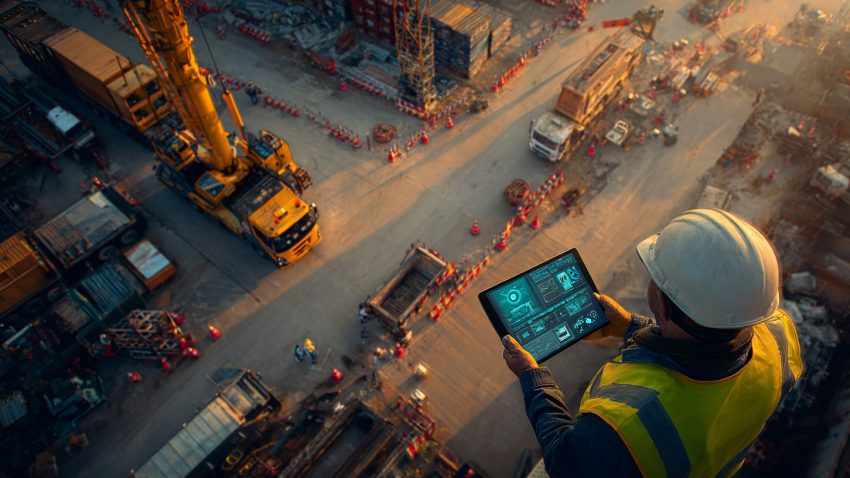Maximizing Sustainability: Advanced Strategies in Construction Materials Management for Green Building
Table of Contents:
In the quest for a more sustainable and environmentally friendly construction industry, the spotlight has increasingly turned toward the principles of green building. This innovative approach not only aims to minimize the impact of construction on the environment but also to create healthier and more energy-efficient spaces for people to live and work in. At the heart of this transformative movement is the strategic management of construction materials, a practice that plays a pivotal role in determining the ecological footprint of any building project.

The Essence of Green Building
Green building transcends the mere use of eco-friendly materials; it embodies a comprehensive approach that encompasses the entire lifecycle of a building, from design and construction to operation and demolition. This philosophy advocates for the efficient use of resources, reduction of waste, and enhancement of the indoor environment, ensuring that projects contribute positively to their surroundings. The benefits of green building are manifold, offering significant reductions in water and energy consumption, lower greenhouse gas emissions, and a healthier living environment for occupants.
The Role of Advanced Construction Materials Management
The efficient management of construction materials lies at the core of green building. This involves meticulous planning and execution to ensure that materials are not only sourced sustainably but are also used efficiently throughout the construction process. Advanced construction materials management strategies encompass a wide range of practices, from selecting renewable or recycled materials to implementing cutting-edge technologies for tracking and optimizing the use of resources.
Sourcing Sustainable Materials
The journey towards green building begins with the careful selection of materials. Sustainable sourcing involves choosing materials that are locally produced, recycled, or renewable, thereby reducing the environmental impact associated with transportation and production. For example, bamboo, a rapidly renewable resource, has emerged as a popular alternative to traditional hardwoods, offering durability and aesthetic appeal while significantly reducing the demand on forests.
Reducing Waste Through Precision and Planning
Waste reduction is a critical aspect of green building, and advanced materials management plays a crucial role in achieving this goal. By leveraging digital tools and software, construction supervisors can precisely calculate the materials required for a project, minimizing excess and reducing waste. Moreover, detailed planning allows for the reuse and recycling of materials, further diminishing the environmental impact of construction activities.
Leveraging Technology for Efficiency
Technology has revolutionized the way construction materials are managed, offering unprecedented levels of efficiency and control. Digital platforms and software applications enable real-time tracking of materials, from procurement to installation, ensuring optimal use and minimizing losses. These technologies also facilitate better communication and coordination among project stakeholders, streamlining the construction process and enhancing overall project sustainability.
The Impact of Effective Materials Management on Green Building
The strategic management of construction materials has a profound impact on the success of green building initiatives. By optimizing the use of resources, projects can achieve significant environmental benefits, from reducing carbon footprints to conserving natural habitats. Moreover, efficient materials management contributes to the economic viability of green building, lowering costs through waste reduction and efficient resource use.
Enhancing Indoor Environmental Quality
Beyond the environmental benefits, effective materials management also plays a pivotal role in enhancing the indoor environmental quality of green buildings. By selecting materials with low emissions of volatile organic compounds (VOCs), construction projects can improve air quality and create healthier indoor environments. This not only benefits the well-being of occupants but also contributes to higher productivity and satisfaction among residents and workers.
Fostering Innovation in the Construction Industry
The focus on materials management in green building is also driving innovation within the construction industry. Manufacturers are increasingly developing new materials and products that are not only environmentally friendly but also offer improved performance and durability. This push towards innovation not only expands the possibilities for green building but also sets new standards for the construction industry as a whole.
The Future of Green Building and Materials Management
As we look towards the future, it is clear that green building and effective materials management will continue to play a crucial role in shaping the construction industry. With the growing awareness of environmental issues and the increasing demand for sustainable living spaces, the principles of green building are set to become the norm rather than the exception. This evolution will require a continued focus on innovation, collaboration, and commitment to sustainability at every level of the construction process.
The journey towards a more sustainable future is both a challenge and an opportunity for the construction industry. By embracing advanced materials management strategies and committing to the principles of green building, we can create not only more sustainable structures but also a healthier, more environmentally friendly world for future generations. The time to act is now, and with every green building project, we take a step closer to realizing this vision.
As the momentum for green building continues to grow, it’s clear that the construction industry stands on the cusp of a significant transformation. This shift towards sustainability is not merely a trend but a fundamental change in how buildings are conceptualized, constructed, and operated. The role of advanced construction materials management in this evolution cannot be overstated, as it directly impacts the environmental, economic, and social pillars of sustainability.
Embracing Collaboration for Sustainable Outcomes
One of the most exciting developments in green building is the increasing emphasis on collaboration across the construction industry. Architects, engineers, construction supervisors, and clients are coming together earlier in the design process to integrate sustainable practices and materials management strategies from the outset. This collaborative approach ensures that sustainability is not an afterthought but a foundational principle of the project. Such partnerships are fostering a new era of innovation, where shared knowledge and goals lead to groundbreaking solutions and advancements in green building.
The Economic Advantages of Green Building
While the environmental benefits of green building are widely recognized, its economic advantages are also significant and deserve mention. Effective materials management not only reduces waste and conserves resources but also translates into cost savings for builders and clients alike. Furthermore, green buildings often command higher rental rates and property values, appealing to an increasingly eco-conscious market. The operational savings in energy and water consumption further underscore the long-term financial benefits of green building, making it a smart investment for the future.
Driving Policy and Change
The global push for sustainability is also shaping governmental policies and regulations, with many countries now implementing standards and incentives for green building. These policies are encouraging the adoption of sustainable practices and materials management across the construction industry. As regulations become stricter and incentives more appealing, we can expect to see a significant increase in green building projects. This regulatory environment, combined with growing public awareness and demand for sustainable living spaces, is driving the construction industry towards more environmentally responsible practices.
Leveraging Data for Sustainability
In the age of information, data plays a crucial role in enhancing the sustainability of construction projects. Advanced management tools are now capable of analyzing vast amounts of data to provide insights into the most efficient use of materials, the optimal design for energy conservation, and the best strategies for waste reduction. This data-driven approach allows for more informed decision-making, ensuring that green building projects are as sustainable and efficient as possible. As technology continues to evolve, the potential for data to transform the construction industry further is immense.

StruxHub
Discover how StruxHub can revolutionize your construction management. Contact us today!
Preparing for a Sustainable Future
Looking ahead, the future of construction is undeniably green. As the industry continues to embrace sustainable practices and advanced materials management, we are moving towards a future where all buildings are designed and built with the health of the planet and its inhabitants in mind. This shift requires ongoing education, innovation, and collaboration, as well as a commitment to sustainability at every level of the construction process.
The journey towards sustainable construction is both exciting and necessary. By prioritizing green building and optimizing construction materials management, we are not just creating buildings; we are shaping a more sustainable, healthier world for generations to come. The construction industry has the opportunity—and the responsibility—to lead this change, transforming our built environment into a testament to our commitment to the planet and each other. Let’s continue to build on this foundation, pushing the boundaries of what’s possible in green construction and materials management, and pave the way for a sustainable future.
The path to a sustainable future is paved with innovation, and the construction industry is at the forefront of this journey. As we embrace the principles of green building and advanced materials management, we are not just altering the landscape of construction; we are redefining what it means to build responsibly. The next steps on this path involve not only the continued adoption of green practices but also a deep commitment to advancing the technologies and methodologies that make sustainable building possible.
Fostering Innovation and Technology
The future of green construction lies in the continuous innovation of materials and construction techniques. From bio-based materials to 3D printing and modular construction, the industry is exploring new frontiers that promise to further reduce environmental impact while enhancing efficiency and durability. These advancements not only offer new opportunities for sustainable building but also challenge us to rethink traditional construction paradigms.
Encouraging Lifelong Learning and Education
As the construction industry evolves, so too must the skills and knowledge of those who work within it. Ongoing education and training in sustainable practices, materials management, and green technologies are essential for construction professionals at all levels. By fostering a culture of lifelong learning, the industry can ensure that its workforce is equipped to meet the challenges of sustainable construction and continue to drive innovation.
Building Resilient and Adaptive Structures
Sustainability is also about resilience and adaptability. As climate change presents new challenges, green buildings must be designed not only to minimize their environmental footprint but also to withstand and adapt to changing environmental conditions. This includes considering factors such as energy efficiency, water conservation, and the use of materials that are both sustainable and durable. By building structures that are resilient and adaptive, the construction industry can contribute to the creation of communities that are better prepared for the future.
Engaging Communities and Stakeholders
The success of green building initiatives also depends on the engagement of communities and stakeholders. By involving local communities in the planning and development process, construction projects can better address local needs and environmental concerns. This collaborative approach not only ensures that projects are more sustainable but also fosters a sense of ownership and pride among community members, leading to more successful and impactful projects.
Looking Ahead with Optimism
As we stand on the brink of a transformative era in construction, the importance of adopting and integrating innovative solutions like StruxHub cannot be overstated. StruxHub is at the forefront of this transformation, offering a suite of tools specifically designed to optimize the management of construction materials, streamline project workflows, and enhance sustainability practices across the board. Their platform embodies the very essence of green construction, enabling professionals to not only meet the current standards of sustainable building but to set new benchmarks for the future.
By choosing StruxHub, construction teams are empowered with real-time data, seamless communication channels, and advanced resource management capabilities, ensuring that every project is not just a testament to sustainability but a step forward in the green construction revolution. The journey towards a sustainable future in construction is filled with challenges, yet it is also ripe with opportunities for innovation, efficiency, and environmental stewardship. StruxHub offers a gateway to this future, providing the tools necessary to transform vision into reality.
StruxHub is a construction project management software that helps you manage projects from start to finish. It offers features like task management, document management, and communication tools. StruxHub can help you save time and money, improve communication, collaboration, and decision-making.
To learn more about how StruxHub can streamline your construction management processes, request a demo today. By completing our form, you’ll hear from our team soon to discuss how StruxHub can help you:
- Schedule construction material deliveries with your trades
- Coordinate construction site resources and on-site logistics
- Digitize work permits and inspection forms
- Communicate and track P6 and Excel schedules
- Broadcast announcements to all construction workers
Don’t miss out on the opportunity to optimize your construction management processes with StruxHub. Sign up for a free demo today.



